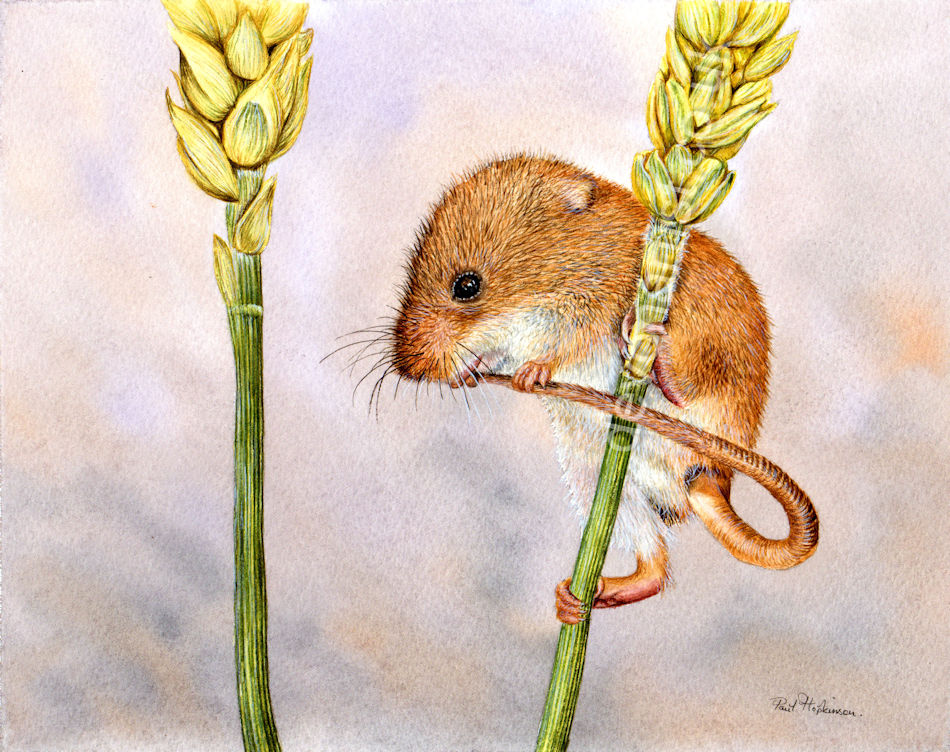Harvest Mouse – Micromys minutus

With the crops ripening around us, the classic image of a Harvest Mouse – Micromys minutus, balancing on an ear of wheat comes to mind. At between 4 and 6g, they have no difficulty sitting on the flimsiest of plants. However, spotting them is a different matter altogether. Indeed, they are very elusive and measuring just 5-7 cm they are very tiny too. We’ve seen them in a captive situation but never in the wild. The photos for my harvest mice projects have been provided by David Newby and Roger Wasley. Two very talented photographers whose work can be found on Flickr, hats off to them, as harvest mice move very quickly.
Characteristics & Distribution
Characterised by their russet brown fur and a little snub nose, they are definitely cute. They have a fur-less prehensile tail, which measures almost as long as their body. This acts as a 5th limb, very handy as they move through the vegetation looking for seeds, berries and insects. In the wild in England, they can be found southwards from central Yorkshire. There are understood to be isolated pockets of them in Scotland and Wales. But these are thought to have occurred as a result of captive populations escaping or being released.


Breeding
On average, a harvest mouse will live for approximately 18 months. They tend to breed between late May and October. Although in mild winters they may carry on for longer, and on average they will have 2 – 3 litters a year. They build a ball-shaped nest, made from tightly woven grasses, usually sited above 30 cm in dense vegetation. The female will generally have around 6 young. Whilst blind and hairless at birth, they grow incredibly quickly. By the 11th day they can be ready for exploring the big wide world – or at least the area around their nest! After about 16 days, the mother will leave her young to fend for themselves. However, a bit like wrens, they continue to return to the nest. A new nest is created for the next litter, as the old nest can become quite worn out with all the toing and froing!

Challenges
Harvest mice certainly live life on the edge. Indeed, they have many predators – foxes, cats, stoats, weasels, owls, hawks and other large birds. The number of species eyeing them up as a light snack means that they are always on the alert. They have an acute sense of hearing and will either freeze where they are or drop to the ground if they sense danger. Their small body size and the need to keep warm results in a high metabolic rate. They are therefore always on the go.

Sadly, changes to our rural landscape have probably resulted in declines in our harvest mouse populations. However, the mouse is now known to live in a much wider habitat and is not just exclusively found within cereal crops. They remain a species for which there are conservation plans in place. Hopefully in the future, their place within our countryside will be more secure and stable.

Watercolour Harvest Mice
If like me, you are taken up with these cute little characters, why not have a go at painting one, or maybe two…..three…four! I have a couple of PDFs featuring harvest mouse, and a full length real time video, in my online school. Or, if you don’t want to paint your own, why not check out my online store, as I have a few of my harvest mouse paintings for sale.
I hope this little insight into the life of a Harvest Mouse – Micromys minutus has been interesting. I just love the Latin name, without knowing any Latin I know exactly what it means! Should you want to find out more, check out the Mammal Society web page.
Until the next time, keep those brushes wet and have a great weekend. Paul







2 responses
Ooh.. so many Mice you made!!! Fantastic Paul. No. 1 is still on my to do list. I know, you do magic.. pls. send some some of them vibes overhere. I sooo not function in this heat
Yes, I have painted a few mice over the years! As for the heat though, Jo and I don’t like it either, it is getting cooler though. 🙂